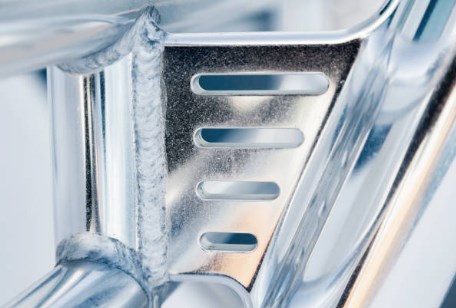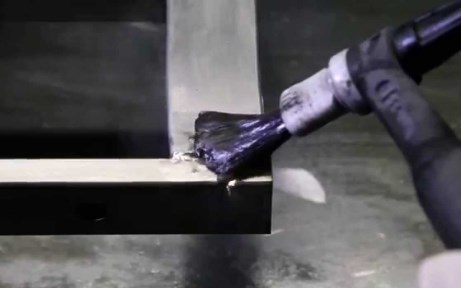I. What's the Importance of Cleaning Stainless Steel Welds?
When it comes to welding stainless steel, ensuring pristine welds isn't just about appearances - it's a crucial step in maintaining durability and preventing corrosion. We delve into the nuances of cleaning stainless steel welds after the TIG welding process, uncovering essential methods and insights that elevate the longevity and aesthetics of your stainless steel.
Stainless steel's allure lies not just in its appearance but also in its inherent resistance to rust and corrosion. However, after TIG welding, this resilience can be compromised. Cleaning the welds thoroughly stands as a barrier against long-term degradation and unsightly annealing colors, safeguarding the stainless steel's integrity and performance.

II. Cleaning Stainless Steel Welds: Three Tried-and-Tested Methods
1. Chemical Method: Pickling Precision
The chemical route involves utilizing a potent pickling fluid comprising hydrofluoric, nitric, and sulfuric acid. This method, while thorough in removing annealing colors, poses risks to both human health and the environment. Industrial suitability is coupled with potential hazards and environmental concerns.
2. Mechanical Method: Brushing Brilliance
Manual brushing, powered by stainless-steel wire brushes or rotating plastic brushes, constitutes the mechanical approach. Although cost-effective, this method demands physical effort and might lead to scratches or missed spots, leaving room for potential corrosion.

3. Electrochemical Method: Efficiency at Its Core
The electrochemical technique, employing electrolyte fluid and electricity, stands as a safe, efficient, and swift option. It efficiently eradicates annealing colors without altering the stainless-steel surface, ensuring a robust and durable finish. Its one-step process accelerates the restoration of the passive layer, shielding the steel against corrosion.
III. What's the Science Behind Stainless Steel?
Delve deeper into stainless steel's composition, comprising over 12.5% chromium and less than 1.2% carbon. This blend triggers a passivation process, forming a protective chromium oxide layer that acts as a shield against rust and corrosion. How to Weld Stainless Steel Easily: 3 Common Methods Compared.
IV. The Vulnerability Post-TIG Welding
The TIG welding process, generating intense heat up to 10,000°C, disrupts this protective layer, leading to the formation of annealing colors. These colors signify the absence of the passive layer, rendering the stainless steel susceptible to rust and bacterial infestation, especially in sensitive sectors like healthcare and food processing. Read TIG Welding Stainless Steel: A Beginners Guide.
V. Choosing the Ideal Cleaning Method
Deciding on the best cleaning method depends on the intricacies of the application and the desired outcomes. Each method has its merits and demerits, necessitating a comprehensive evaluation:
1) Chemical Cleaning - A Comprehensive Yet Hazardous Approach
Pickling, despite its thoroughness, poses risks to human health and the environment, demanding meticulous safety measures and disposal practices.
2) Mechanical Cleaning - Cost-Effective Yet Labor-Intensive
While cost-efficient, mechanical cleaning through brushing or cloth usage requires physical effort and may not cover all vulnerable spots, leaving room for potential corrosion.
3) Electrochemical Cleaning - The Swift and Safe Solution
Efficient and reliable, electrochemical cleaning stands out for its one-step process that ensures quick restoration of the passive layer, mitigating the risk of corrosion.
VI. Qualities of a Superior Weld Cleaning Device
If opting for electrochemical cleaning, consider these pivotal factors when selecting a weld cleaning device:
Provider's expertise in welding technology
User-friendly operation
Minimal fluid consumption with precise dosing
Energy-efficient design
Sturdy yet lightweight construction
Diverse accessories for various applications
Accessible distributor and service network
VII. Conclusion: Navigating the Realm of Stainless Steel Weld Cleaning
The meticulous process of cleaning stainless steel welds post-TIG welding is an indispensable step toward preserving the material's integrity and aesthetics. Understanding the nuances of each cleaning method and leveraging cutting-edge technology can ensure a durable and visually appealing stainless-steel finish. You may also be interested in How To Clean Stainless Steel Welds After Welding. [Easiest Way].
Frequently Asked Questions
Q1. What are the risks associated with the chemical cleaning of stainless steel welds?
A1: Chemical cleaning poses hazards to human health and the environment due to its use of aggressive acids like hydrofluoric, nitric, and sulfuric acid.
Q2. Can mechanical cleaning guarantee the complete removal of annealing colors?
A2: While effective, mechanical cleaning methods like brushing or cloth usage may miss certain spots, potentially leaving areas vulnerable to corrosion.
Q3. How efficient is electrochemical cleaning in restoring the passive layer on stainless steel?
A3: Electrochemical cleaning is remarkably efficient, offering a one-step process that swiftly restores the passive layer, safeguarding against corrosion.
Q4. What factors should one consider when selecting an electrochemical weld cleaning device?
A4: Critical factors include the provider's expertise, ease of operation, minimal fluid consumption, energy efficiency, durability, accessory diversity, and a reliable service network.





